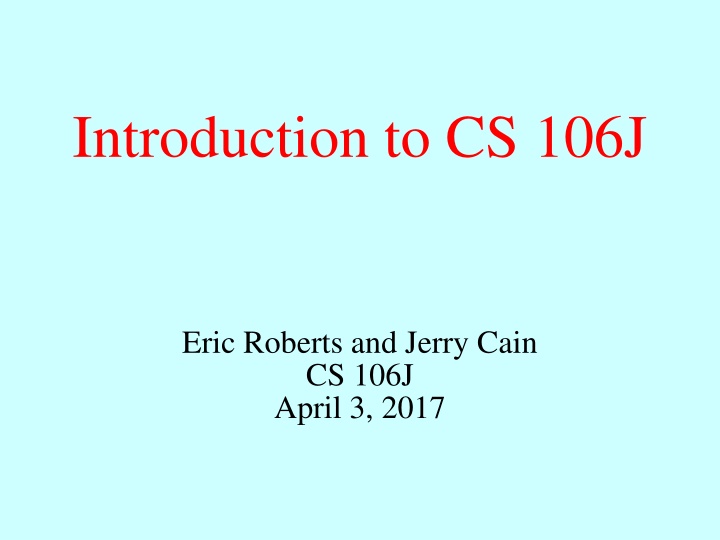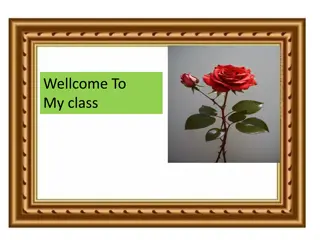
Programming Methodology in JavaScript at Stanford University
Explore CS 106J - an introductory course in computer science focusing on programming methodology in JavaScript. Learn about object-oriented design, decomposition, encapsulation, and more. No prior coding experience required. Discover why JavaScript is a popular language and the importance of studying computer science. Meet the course staff and get ready to delve into the world of coding.
Uploaded on | 0 Views
Download Presentation

Please find below an Image/Link to download the presentation.
The content on the website is provided AS IS for your information and personal use only. It may not be sold, licensed, or shared on other websites without obtaining consent from the author. If you encounter any issues during the download, it is possible that the publisher has removed the file from their server.
You are allowed to download the files provided on this website for personal or commercial use, subject to the condition that they are used lawfully. All files are the property of their respective owners.
The content on the website is provided AS IS for your information and personal use only. It may not be sold, licensed, or shared on other websites without obtaining consent from the author.
E N D
Presentation Transcript
Introduction to CS 106J Eric Roberts and Jerry Cain CS 106J April 3, 2017
Course Description CS 106J: Programming Methodology in JavaScript Introduction to the engineering of computer applications emphasizing modern software engineering principles: object-oriented design, decomposition, encapsulation, abstraction, and testing. Emphasis is on good programming style. This course covers the same material as CS 106A but does so using JavaScript, the most common language for implementing interactive web pages, instead of Java. No prior programming experience required. Enrollment limited to 100. Terms: Spr | Units: 3-5 | UG Reqs: WAY-FR | Grading: Letter or CR/NC CS 106J covers the same material and meets the same WAYS requirements as any other CS 106A section.
Why JavaScript? When Stanford adopted Java a little over a decade ago, we expected along with its designers that it would become the language of the web. That didn t happen. Today, the language of the web is JavaScript, which has become the most widely used language in industry. Along with JavaScript expert Douglas Crockford, we believe that, as long as you avoid some of its most commonly abused features, JavaScript is a beautiful, elegant, highly expressive language that is ideal for a first course in programming. It is considerably easier to learn than Java. There are far fewer confusing details to memorize. It offers much cleaner implementations of modern features. It is universally supported on the web.
Why Study Computer Science? Sources: National Center for Education Statistics 2014; Bureau of Labor Statistics 2014-2024 projections. We are very happy with the students that we get from this university. . . . We just wish we could hire two to three times as many of them. Bill Gates at Stanford, February 19, 2008
Everyone Needs Some Programming Half of all jobs in the top income quartile value coding skills. Source: Burning Glass Technologies, Beyond Point and Click: The Expanding Demand for Coding Skills, June 2016.
CS 106J Course Staff Eric Roberts eroberts@cs.stanford.edu Office Hours (Gates 202): Tuesdays 9:30 11:00 Jerry Cain jerry@cs.stanford.edu Office Hours (Gates 192): Wednesdays: 3:30 5:00 Jason Chen cheson@stanford.edu Office Hours (TBA): TBA
SyllabusWeek 1 April 3 5 7 Administration Course overview Meet Karel the Robot Simple Karel programs Control structures in Karel Problem-solving in Karel Program decomposition The idea of an algorithm Read: Sections 1.1-1.3 Read: Sections 1.4-1.5
SyllabusWeek 2 10 12 14 Programming by example Variables and values Arithmetic expressions Functions Strings and concatenation Simple graphics Control statements Boolean data Read: Sections 2.1-2.4 Read: Sections 2.5-2.6 Read: Sections 3,1-3.5
SyllabusWeek 3 17 19 21 Arguments and parameters Libraries Random numbers The mechanics of functions Decomposition First-class functions Event-driven programming Responding to mouse events Read: Sections 4.1-4.2 Due: HW #1 (Karel) Read: Sections 4.3-4.4 Due: Karel contest Read: Sections 5.1-5.4
SyllabusWeek 4 24 26 28 The GArc class The GPolygon class The GCompound class Simple animation Timers Binary representation Representing characters Read: Section 5.5 Due: HW #2 (Simple JS) Read: Section 5.6 Read: Section 6.1
SyllabusWeek 5 May 1 3 5 JavaScript s String class Common string patterns Problem solving with strings String applications Cryptography The GLabel class Read: Section 6.5 Due: HW #3 (Breakout) Read: Sections 6.2-6.3 Read: Section 6.4
SyllabusWeek 6 8 10 12 Debugging strategies Simple arrays and files Using arrays for tabulation Midterm Exam Tuesday, May 9 3:30P.M. or 7:00P.M. Due: Graphics contest Read: Sections 7.1-7.2 Read: Section 7.3
SyllabusWeek 7 15 17 19 Multidimensional arrays Pixel arrays The GImage class Objects as aggregates JavaScript and OOP Libraries and interfaces Defining classes and methods Read: Sections 7.4-7.5 Due: HW #4 (HangKarel) Read: Sections 8.1-8.2 Read: Sections 8.3-8.5
SyllabusWeek 8 22 24 26 Objects as maps Large-scale data structures Data-driven programs Overview of Adventure! Read: Adventure handout Due: HW #5 (Yahtzee) Read: Section 8.6 Read: Section 8.7
SyllabusWeek 9 29 31 June 2 Memorial Day JavaScript and the web Using web interactors (no class) Read: (handouts for the day) Read: (handouts for the day)
Dead Week and Beyond 5 7 Looking ahead Frontiers of computing (optional) Due: HW #6 (Adventure) Due: Adventure contest Read: (handouts for the day) Review session: Monday, June 12 7:00-9:00P.M. Final exam: Wednesday, June 14 8:30-11:30A.M.
Assignments in CS 106J Assignments in CS106J are due at 5:00P.M. Assignments that come in after 5:00 will be considered late. Everyone in CS 106J starts the quarter with two latedays that you can use at any time you need some extra time. In my courses, late days correspond to class meetings, so that, if an assignment is due on Wednesday and you turn it in on Friday, that counts as onelate day. Extensions can be approved only by the TA, Jason Chen. Assignments are graded by your section leader, who discusses your work in an interactive, one-on-one grading session. Each assignment is given two grades: one on functionality and one on programming style. Style matters. Companies in Silicon Valley expect Stanford graduates to understand how to write code that other programmers can maintain.
The CS 106J Grading Scale Functionality and style grades for the assignments use the following scale: A submission so good it makes you weep. Exceeds requirements. Satisfies all requirements of the assignment. Meets most requirements, but with some problems. Some more serious problems. Even worse than that. Why did you turn this in?
Contests CS 106J will have three contests as follows: The Karel Contest associated with Assignment #1 The Graphics Contest associated with Assignment #3 The Adventure Contest associated with Assignment #6 First prize in the contest is a score of 100% on one of the graded components of the course, typically the final exam. As an additional incentive, entering any of the contests gives you a virtual ticket to win an additional grand prize in a random drawing at the end of the quarter. So does receiving a runner-up or honorable mention on a contest and finding errors in the text and tools. Entering a contest also earns housepoints for your class in the style of the Hogwarts School from Harry Potter.
Honor Code Rules Rule 1: You must not look at solutions or program code that is not your own. Rule 2: You must not share your solution code with other students. Rule 3: You must indicate on your submission any assistance you received.
Meet Karel the Robot The only other objects that exist in Karel s world are beepers, Initially, Karel understands only four primitive commands: Karel s world is composed of streets and avenues numbered from the southwest corner. (As in Manhattan, streets run east- west and avenues run north-south.) In this world, Karel is walls in the interior of the world that block Karel s passage. In this world, for example, I ve added a beeper to the corner turnLeft() Turn 90 degrees to the left Karel the Robot was developed here at Stanford by Richard Pattis over 30 years ago. Since then Karel has given many generations of CS 106J students a gentleintroduction to programming and problem solving. facing east at the corner of 1st Street and 1st Avenue. of 1st Street and 2nd Avenue. pickBeeper() Pick up a beeper from the current square putBeeper() Put down a beeper on the current square Karel s world is surrounded by a solid wall through which it cannot move. Depending on the problem, there may also be which are small plastic cones that emit a quiet beeping noise. move() Move forward one square 3 + + + + + + + + + + 2 + + + + + 1 1 2 3 4 5
Your First Challenge How would you program Karel to pick up the beeper and transport it to the top of the ledge? Karel should drop the beeper at the corner of 2ndStreetand4thAvenue and then continue one more corner to the east, ending up on 5thAvenue. 3 + + + + + + + + + + 2 + + + + + 1 1 2 3 4 5





